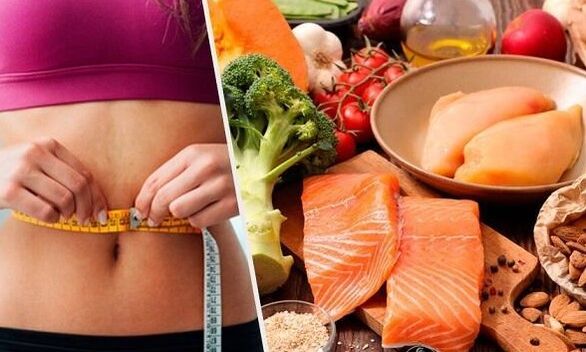The ketogenic diet (keto) is a very low -carbohydrate diet that promotes fat burning. There are many benefits to weight loss and better health, but also some side effects.
- The plus of the keto diet
- Which is forbidden in the keto diet
- How to find out what you are in ketoss?
- Side effects of diet and how to avoid them
The ketogenic diet is similar to other strict low -carbohydrate diets such as Atkins or LCHF diets. These diets often end with more -less ketogen. The main difference between the strict LCHF and the keto diet is that protein in the latter is limited.
With ketosis, the body produces small fuel molecules called "ketones". This is an alternative fuel for the body.
Ketons are produced when they eat very little carbohydrates (which are rapidly divided into blood sugar) and moderate amounts of protein (can be used for blood glucose levels).
How to lose weight in baby food?
Ketons are formed in the liver of the fats. They are then used as fuel throughout the body, including the brain. The brain is an organ that consumes a lot of energy every day and cannot directly on fat. Can only work on glucose or ketones.
For a ketogenic diet, the entire body switches from fuel supply with carbohydrates and works almost completely on fat. Insulin levels are very low and fat burning suddenly increases. The body is easily accessible to its own fat reserves to burn them.
The plus of the keto diet
The benefits of the ketogenic diet are similar to all strict, low maintenance. However, the effect can be even higher as the protein is limited. Such a diet increases the level of ketone and reduces insulin levels. 
- In the keto diet, the burning of fat increases significantly as insulin falls. This creates the ideal conditions under which weight loss can occur without hunger.
- About 20 scientific studies show that a low -carbohydrate and keto diet leads to more effective weight loss when compared to other diets.
- Ketosis leads to the brain to sustainable fuel intake (ketones). And in a ketogenic diet you can avoid large fluctuations in blood sugar. This often leads to an increase in attention and increased concentration.
- Many people specifically use the keto diet to increase mental performance. After a few days (up to a week), keto-adaptation, where people may have difficulties with concentration, headache, irritability-the body and the brain, and can easily work on ketones.
- In a state of ketosis, many people experience more energy.
- The ketogenic diet can also significantly increase physical perseverance, providing continuous access to energy from fat reserves.
- The body with carbohydrates (glycogen) is sufficient for only a few hours of intensive workouts or less. When, as fat reserves add sufficient energy to long and intensive care classes.
Which is forbidden in the keto diet
The most important thing is to avoid using carbohydrates to achieve ketosis, ideally reducing consumption below 20 grams. The less carbohydrates, the more effective.
How to find out what you are in ketoss?
Ketosis can be measured by testing urine, blood or breathing. But there are clear signs. Symptoms of ketosis: dry mouth, thirst, frequent urination.
Dry mouth and increased thirst. If you drink enough and have enough electrolytes, you can feel the dry mouth. Try drinking one or two cups of broth daily and drinking as much water as you need.
Increase in urination is another symptom of ketosis.
Keto-drying-due-ketontes, the acetone scent appears from the mouth, the odor can be "fruit" or similar to the smell of the varnish fluid. This odor is sometimes felt by sweat, all passing away for a short period of time and after the keto adaptation has been handed over.
Other, less specific but more positive signs are as follows:
Reducing hunger - many people experience a noticeable decline. This may be due to the increased body of the body to feed it by its fat reserves. Many people feel good, eat only once or twice a day, and can make regular fasting. This saves time and money and accelerates weight loss.
Energy growth - after a few days, the feeling of fatigue disappears and will feel the increase in energy and performance.
How to achieve sustainable ketosis
- Limits carbohydrates up to 20 grams a day.
- Squirrel restriction to moderate level. 1 gram of protein per day should be stayed at a weight / body weight or below 1 gram. It is 70 grams of protein a day when weighs 70 kilograms.
- There is sufficient amounts of fat to be full.
- Avoid snacks if not hungry. Excess snacks slow down weight and reduce ketosis.
If necessary, it is necessary with periodic hunger, such as 16: 8-16 hours hunger and 8 hours for food consumption. This is very effective in increasing ketones.
Side effects of diet and how to avoid them

In the early stages of switching to keto mode, side effects may occur, called Keto -gripp. Symptoms such as fatigue, nausea, headaches, cramps, etc. occur. What to do to prevent or alleviate these symptoms:
- Drink water with salt and lemon - you should drink a cup of soup daily.
- Gradually reduce carbohydrate consumption - sharp decrease leads to stronger symptoms
In the early stages of the ketogenic diet, it loses water and therefore electrolytes. This is because carbohydrates delay water and salt in the body, so when you stop consuming carbohydrates, the body loses this water.
When carbohydrates are suddenly removed from the diet, the brain needs time before learning ketone bodies for energy instead of sugar. This means that if you reduce your carbohydrates sharply, you can get symptoms, such as fatigue, nausea and headache. Reduce carbohydrate consumption for one or more weeks, the body gets used to burning fats and ketones instead of glucose, and the transition occurs more easily and without symptoms.






























